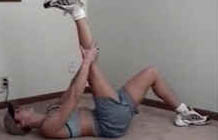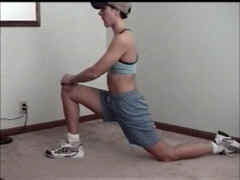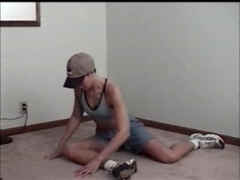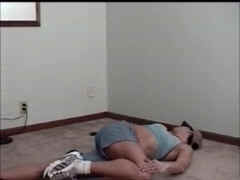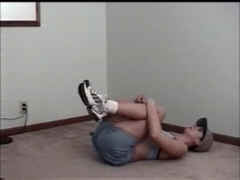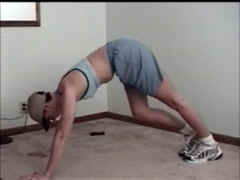by J. R. McNeal, M. S., C.S.C.S. and W.A. Sands, Ph.D.
The fitness industry is replete with exercise devices designed to enhance fitness or sculpt the body. They are marketed to the unsuspecting and often gullible consumer, promising quick fixes and effortless results. Oh, if only it was that easy! Considering the amount of money Americans spend on fitness gadgets, we should be the fittest nation in the world instead of the fattest! One of the most recent trends in the industry is the emergence of the various abdominal conditioning devices, designed to “isolate” the abdominals (as if that were possible!), reduce neck strain, and in general make exercising the abdominal muscles an enjoyable experience. Are all of these devices created equal? How do they compare to a regular crunch, or the “forbidden” situp? The purpose of our investigation was to answer these questions. We decided to compare 6 different commonly performed exercises and devices to see if indeed there are differences in muscle activation and range of motion. By comparing the amount of muscle activation achieved, we can make recommendations regarding the relative value of one exercise over another with respect to force generated by the target muscles (the abs). Range of motion meanwhile, is a variable that has been virtually ignored in the fitness research literature. Watch virtually any throwing activity for example, and you can see that the range of motion of the trunk during such movements is large indeed.
We asked 20 active, college-aged students to participate in this investigation (10 females, 10 males). The exercises selected were 1) a regular crunch from the floor, 2) a regular situp with feet constrained, 3) a situp with the addition of the AbMat™ pad, 4) a crunch performed with an ab-roller type device, according to the recommendations of the manufacturer, 5) a crunch performed with the ab-roller combined with the AbMat™ pad, and finally 6) trunk flexion utilizing the Ab Bench resistive device. The exercises were demonstrated to the subjects, and they were allowed to practice each until they were comfortable with their performance. They were then videotaped with high-speed video while performing 3 trials of each exercise. Various anatomical structures of the subject were marked with reflective tape so that they were evident on the screen. This allowed the videotaped performances to be digitized and analyzed for specific kinematic information; in this case, angular displacement. Electromyography electrodes were placed on the upper and lower abdominals to assess muscle activity.
Findings:
For the lower trunk angle, the AbMat™ and Ab Bench achieved significantly greater ranges of motion than did the ab-roller exercises, the situp, or the regular crunch, although the traditional situp was significantly better than the ab-roller exercises and the regular crunch. At the hip and upper trunk angles it was again discovered that the AbMat™, Ab Bench, and the traditional situp were better than the ab-roller devices or the regular crunch at moving through a large range of motion. In most cases, the ab-roller exercises and the regular crunch did not differ from eachother, making the purchase of an ab-roller for specifically conditioning the abdominals questionable when compared to the regular crunch, which doesn’t cost anything! However, if the goal is exceptional conditioning of the abdominals through a large (“functional”) range of movement, then devices such as the AbMat™ and Ab Bench, which place the abdominal muscles in a slightly stretched position prior to each repetition, may be a wise equipment investment.
The muscle electrical activity provided even more insight into the efficacy of these particular exercises. It was of particular interest to us that the recordings from the abdominals could be described by different characteristic recordings; the regular crunch, ab-roller exercises, and the AbMat™ were characterized by a continuous activation pattern with a low amplitude (low force output), while the Ab Bench and situp were described by two distinct phases, concentric and eccentric which were of much higher amplitude. We did not feel we could adequately compare the two groups of exercises against each other due to these differences and thus the results basically compare exercises within each group. This is one example of the problems that can influence the results of electromyography studies of the abdominals, and any study not accounting for these differences should be considered with some reservation. Another problem which is inherent in electromyography investigations of the abdominals (but rarely if ever acknowledged by researchers in their results!) is the problem of skin and fat rolling that occurs whenever the trunk flexes. This makes the nature of the muscle electrical activity change as the electrode moves farther from and closer to the muscle. We feel that it is important to be aware of such shortcomings in this type of research so that you can become a more knowledgeable consumer.
The continuous activation exercises were not different in their activation of the upper abdominals. However, for the lower abdominals the AbMat™ elicited significantly more activity than did the ab-roller exercises. The regular crunch was superior only to the ab-roller exercise used simultaneously with the AbMat™. Therefore, the AbMat™ seems to be the superior exercise of this group for eliciting muscle activation, especially when the lower abdominals are considered.
The situp and Ab Bench exercises as stated earlier, were different in their EMG patterns. Because the EMG was greater in these exercises, but occurred over a shorter time period, these exercises may be better choices if large force production is desired, rather than muscular endurance. For both the upper and lower abdominals the situp produced greater activation than the Ab Bench. It is critical to note, however, that due to the limitations of this study and these typical subjects, we were not able to approach any kind of maximal load on the Ab Bench. The Ab Bench allows resistance to be added to the exercise, which would cause an increase in muscle activation to move the increased load. In other words, one should be able to get any level of activation up to a maximum with the Ab Bench. The situp is constrained by the weight of the individual’s upper body. This was likely a major drawback in the ability of this study to properly distinguish between these two exercises. Common sense would tell us that if we were able to increase the resistance provided by the Ab Bench, the muscle activation results would have been different.
In conclusion, it can be recommended that ab-roller devices may not be any better than the regular crunch in conditioning the abdominals. For specificity of movement, equipment such as the AbMat™ and Ab Bench which place the spine in a slightly hyperextended position prior to abdominal contraction may be better choices, especially for sport performance. The situp appears to also be a good choice for both range of motion and activation, although it is limited in the amount of resistance and thus less muscle activation which can be achieved
J. R. McNeal, M. S., C.S.C.S.
W.A. Sands, Ph.D.
Dept. Of Exercise
SLC, UT. 84112


